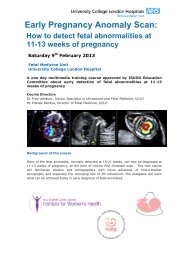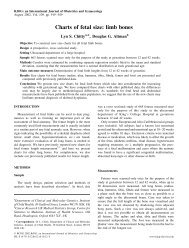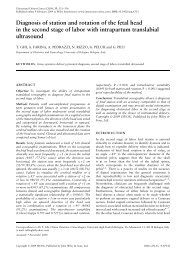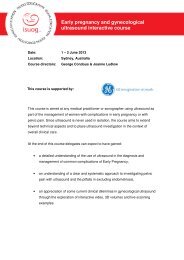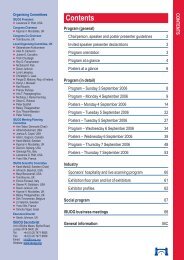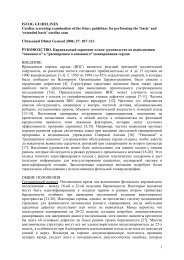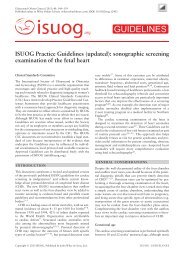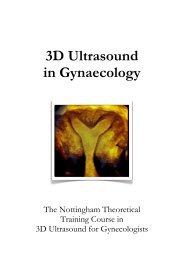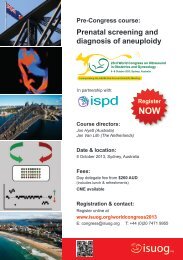Middle cerebral artery peak systolic velocity: a ... - IngentaConnect
Middle cerebral artery peak systolic velocity: a ... - IngentaConnect
Middle cerebral artery peak systolic velocity: a ... - IngentaConnect
Create successful ePaper yourself
Turn your PDF publications into a flip-book with our unique Google optimized e-Paper software.
MCA-PSV and IUGR 311<br />
perinatal mortality in preterm IUGR fetuses that have<br />
an abnormal UA-PI, to compare the performance of<br />
the MCA-PI, MCA-PSV, and UA absent or reversed<br />
end-diastolic flow <strong>velocity</strong> (ARED) in the prediction of<br />
perinatal mortality in these fetuses, to determine the<br />
longitudinal changes that occur in the MCA-PI and MCA-<br />
PSV in these fetuses, and to test the hypothesis that the<br />
MCA-PSV can provide additional information on the<br />
prognosis of hypoxemic IUGR fetuses.<br />
MATERIAL AND METHODS<br />
This study included a retrospective and a prospective<br />
assessment of the MCA-PSV and MCA-PI. All patients<br />
were enrolled into research protocols approved by a<br />
human investigation committee.<br />
Among 55 fetuses diagnosed with IUGR, we selected<br />
singletons that had: (a) an estimated weight < 3 rd<br />
percentile (confirmed at birth), (b) a UA-PI > 95 th<br />
CI, (c) normal anatomy and (d) an MCA Doppler<br />
examination determined with an angle close to 0 ◦ within<br />
8 days before delivery or fetal demise. All were delivered<br />
at < 33 weeks’ gestation.<br />
Thirty fetuses met the entry criteria. The gestational age<br />
at the time of the Doppler study ranged between 23+0and<br />
32+4 (median,27+2) weeks, based on the last menstrual<br />
period for women with a recorded history or on a secondtrimester<br />
scan. Delivery was indicated in the presence<br />
of: (a) non-reassuring fetal testing, (b) fetal demise, or<br />
(c) worsening maternal or fetal conditions as determined<br />
by the managing physician. Non-reassuring fetal testing<br />
was defined as the presence of either continuous late<br />
decelerations or a biophysical profile < 4. When delivery<br />
was indicated and the fetus was < 500 g in weight,<br />
the patient was counseled on the poor prognosis and<br />
offered the option of non-intervention. For fetal weight,<br />
we utilized the normal reference ranges established by<br />
Hadlock et al. 8 .<br />
Doppler studies<br />
Pulsed-wave Doppler ultrasound studies were performed<br />
with four color Doppler systems (Sequoia, Siemens<br />
Medical Solutions, Mountain View, CA, USA; Voluson<br />
530 or 730 Expert, GE Medical Systems, Milwaukee,<br />
WI, USA; HDI 5000, Philips Medical Systems, Bothell,<br />
WA, USA) using 3.5- or 5-MHz probes with spatial <strong>peak</strong><br />
temporal average intensities of < 100 mW/cm 2 in both<br />
imaging and Doppler modes. All recordings were obtained<br />
in the absence of fetal breathing and fetal movements.<br />
For each vessel, an average of three consecutive Doppler<br />
<strong>velocity</strong> waveforms was used for statistical analysis. A<br />
free loop of the UA was sampled, and the PI was used<br />
to analyze the waveforms 9 . The MCA was studied with<br />
an angle close to 0 ◦ between the ultrasound beam and<br />
the direction of blood flow, as reported previously 5 .The<br />
MCA waveforms were quantified using the PI as well<br />
as the PSV. The MCA-PI was considered abnormal if<br />
the measurements were below the lower limit of normal<br />
as reported previously 4 ; the MCA-PSV was considered<br />
abnormal if the measurements were above the upper limit<br />
of normal, as established previously 5 .AUA-PI> 95%<br />
CI for gestational age of our reference range was also<br />
considered abnormal, as was ARED in the UA.<br />
Prospective longitudinal study<br />
Of the 30 IUGR fetuses, we prospectively assessed 10<br />
in which the MCA-PI and the MCA-PSV were recorded<br />
longitudinally from the time the diagnosis was made<br />
until delivery. The number of measurements in these<br />
fetuses ranged from 3 to 8 (median, 5). Gestational ages<br />
at entrance into the study ranged from 20+6 to26+4<br />
(median, 23+5) weeks, and gestational ages at delivery<br />
were between 23+1 and 28+6 (median,26+1) weeks.<br />
Perinatal outcome endpoints included: (a) perinatal<br />
mortality, defined as mortality occurring between<br />
20 weeks’ gestation and 28 days after birth and<br />
Table 1 Demographics of the study population (n = 30)<br />
Characteristic<br />
Median (range)<br />
GA at Doppler study (weeks) 27+2 (23+0–32+4)<br />
Interval between last scan and delivery 1 (0–8)<br />
(days)<br />
GA at delivery (weeks)<br />
Total population 27+6 (23+1–32+5)<br />
Perinatal deaths (n = 11) 25+5 (23+1–28+6)<br />
IUFDs (n = 6) 25+8 (23+1–28+6)<br />
NDs (n = 5) 25+0 (24+6–28+1)<br />
Survivors (n = 19) 29+2 (25+2–32+5)<br />
Birth weight (g)<br />
Total population 540 (282–1440)<br />
Perinatal deaths (n = 11) 440 (282–660)<br />
IUFDs (n = 6) 430 (282–472)<br />
NDs (n = 5) 471 (300–660)<br />
Survivors (n = 19) 760 (360–1440)<br />
GA, gestational age; IUFD, intrauterine fetal demise; ND, neonatal<br />
death.<br />
MCA-PSV (cm/s)<br />
100<br />
90<br />
80<br />
70<br />
60<br />
50<br />
40<br />
30<br />
20<br />
10<br />
0<br />
15 20 25 30 35 40<br />
Gestational age (weeks)<br />
Figure 1 <strong>Middle</strong> <strong>cerebral</strong> <strong>artery</strong> <strong>peak</strong> <strong>systolic</strong> <strong>velocity</strong> (MCA-PSV)<br />
in 30 growth-restricted fetuses plotted on the normal reference<br />
range 5 , showing fetuses which died (ž) and those which<br />
survived (<br />
° ).<br />
Copyright © 2007 ISUOG. Published by John Wiley & Sons, Ltd. Ultrasound Obstet Gynecol 2007; 29: 310–316.




